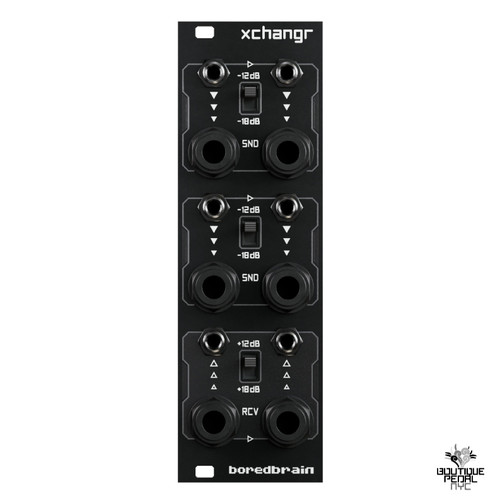Product Overview
S/PDIF DIGITAL CONVERTER
- Encodes 2 analog inputs into a S/PDIF digital signal
- Decodes a S/PDIF digital signal into 2 analog outputs
- DC-coupled inputs and outputs support both CV and audio signals
- Selectable 44.1/48 kHz internal sample clock or external sync
- Digital coaxial cable connectors for S/PDIF signals (RCA)
Compact digital conversion
Spdf is a digital signal encoder and decoder for eurorack modular synthesizers. The module converts analog audio and CV signals to and from the S/PDIF format to interconnect digitally with computer audio interfaces and other S/PDIF enabled devices.
S/PDIF Encoding & Decoding
Many audio interfaces are equipped with S/PDIF expansion ports allowing for two additional channels of input and output. Spdf takes advantage of these often unused ports, providing a digital interconnection between a computer and eurorack system.
The module accepts a 2-channel S/PDIF signal at the Rx jack (via coaxial digital cable) and converts it into two discrete analog signals available at the OUT 1 and OUT 2 jacks. Conversely, Spdf accepts two discrete analog signals at the IN 1 and IN 2 jacks and converts them into a 2-channel S/PDIF signal available at the Tx jack.
The most common configuration uses a bi-directional digital interconnection. The audio interface must have both S/PDIF In and Out ports, and the module is set to external sample clock sync.

NOTE: With the SYNC switch set to EX, the blue EXT SYNC LED will illuminate when a valid sample clock is detected at Rx.
A uni-directional digital connection is used if the audio interface has only a S/PDIF In port. The module is set to generate internal sample clock, and the interface is set to external sample clock sync.

NOTE: With the SYNC switch set to IN, the S/PDIF Rx port is completely disabled, and only the S/PDIF Tx port is active.
In addition to computer audio interfaces, Spdf can connect digitally to many other types of gear equipped with S/PDIF coaxial ports. This includes keyboards and samplers, DJ mixers and multi-player decks, digital speakers, and consumer electronics such as TVs, stereo systems, CD players and more.
IMPORTANT: Use digital coaxial cables (75 Ω) for optimal signal transmission, not regular RCA audio cables.
Analog I/O
The module’s analog inputs and outputs are DC-coupled (selectable for inputs), which means Spdf can encode and decode DC signals like control voltages. When used in conjunction with software such as Bitwig Studio or Ableton CV Tools, the module can be used to send and receive control voltages like 1V/oct pitch signals, gates, triggers, LFOs, ADSRs, and other modulators.
Spdf can also be used to digitally encode and decode audio signals. AC-coupling for the inputs may be selected (default setting), which will enable an inaudible high-pass filter to remove any DC offset prior to S/PDIF encoding.
All i/o circuitry has been carefully designed and routed for low-noise performance, with buffered inputs and outputs scaled to accept eurorack signals up to ±10 V.
Synchronization Settings
Spdf will operate only when locked to sample clock of 44.1 kHz or 48 kHz, either from an external source (S/PDIF Rx signal) or internally generated. Three DIP switches on the back of the module may be used to configure these settings, as well as to select DC or AC coupling of the inputs.
| SYNC | |
|---|---|
| IN | Generates and syncs to internal sample clock |
| EX | Syncs to external clock from S/PDIF Rx |
| RATE | |
|---|---|
| 48 | Sets the sample clock rate to 48 kHz |
| 44 |
Sets the sample clock rate to 44.1 kHz |
| CPL | Input Coupling |
|---|---|
| DC | Enables DC-coupling for CV signals |
| AC | Enables AC-coupling for audio signals |
technical specs
- Width: 5 HP
- Depth: 1.0 in (25 mm)
- Weight: 1.2 oz (34 g)
- Resolution: 24 bit, 44.1/48 kHz
- Max I/O Level: ±10 V (20 Vpp)
- Noise Floor: -93 dBFS
- Power: +12 V 55 mA, -12 V 10 mA

patch tips
CV/GATE & AUDIO RETURNS – Use CV capable software such as Bitwig Studio or Ableton CV tools to send pitch and gate signals to Spdf outputs. Patch them respectively into a 1V/oct oscillator and envelope gate input. Then patch the audio signal(s) back to the Spdf inputs to mix within the DAW software. Instrument tracks can then contain both the sequence data and audio returns for simple and powerful integration with your eurorack synth.
NOTE: 1V/oct signals will require calibration within the software.












